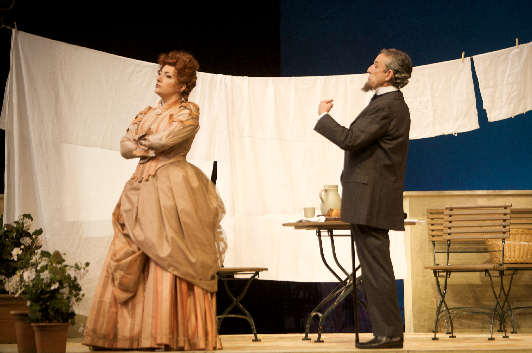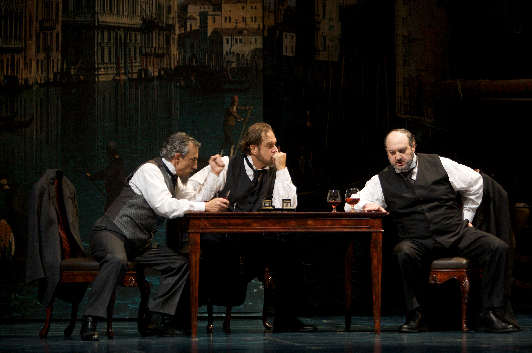Other Links
Editorial Board
- Editor - Bill Kenny
- London Editor-Melanie Eskenazi
- Founder - Len Mullenger
Google Site Search
SEEN
AND HEARD INTERNATIONAL OPERA REVIEW
Wolf-Ferrari, I Quattro Rusteghi:
Soloists, Orchestra National du Capitole. Conductor:
Daniele Callegari. Théâtre du Capitole de Toulouse.
29.2.2008 (JMI)
It
was rather a surprise to find Wolf-Ferrari's I Quattro Rusteghi
or 'The School for Fathers' at the Toulouse Capitole , since it is
hardly performed anywhere outside of Venice and Zurich. Best
known for Il Segreto de Susanna this Italian-German
composer has almost disappeared from opera houses everywhere,
surely due the lack of interest of his subject matter. Of the
rest of his operatic production, Sly had some years of
popularity with Carreras and Domingo, whereas Il Campiello
continues to be a true rarity even in
It is
rather difficult for me to judge Daniele Callegari's conducting,
as I don't know this opera very well. Considering the
difficulties to putting it all together in the first place however
it did seem that he conducted with a firm hand and there were no
problems of coordination between stage and pit. As far as his
reading went I had the feeling that he needed more lightness at
some points and The Orchestra du Capitole played very well,
although not reaching quite the same quality as in The Queen of
Spades a few weeks ago.
Production from
Zurich
Opera.
Direction: Grischa Asagaroff.
Sets and Costumes: Luigi Perego.
Lighting: Hans-Rudolf Kunz
Cast:
Lunardo: Roberto Scandiuzzi.
Lucieta: Diletta Rizzo-Marin.
Margarita: Marta Moretto.
Simon: Carlos Chausson.
Marina: Chiara Angella.
Maurizio: Paolo Rumetz.
Filipeto: Luigi Petroni.
Canciano: Giuseppe Scorsin.
Felice: Daniela Mazzucato.
Ricardo: Franceso Piccoli.

The
Capitole offers a production by Grischa Asagaroff Zurich Opera
which is not terribly interesting and gives the impression that
it is rather old. It consists of a simple set with a revolving
central element, always showing a view of
Venice and
its canals and finishing the opera with a new Venetian with a
gondola for the newly betrothed young couple. The fact that the
action takes place during Carnival could have been better
developed by the director, particularly with brighter costumes.
This is an opera made up of ensembles and requires an exceptional
director, as well very good actors on stage. Asagaroff is not
particularly outstanding in managing all this , although he does
meet the objective of entertaining the audience.

The most important character in the opera is Lunardo, the rich and
rude Venetian antique dealer, who wants to marry off his daughter
without caring what she thinks. This role was interpreted by
Roberto Scandiuzzi ( born himself in the
Scandiuzzi's daughter in the work is Lucieta and was performed by
his daughter in real life, the young (23 years) Diletta
Rizzo-Marin, who replaced the promised Alessandra Marianelli at
short notice. She was a good interpreter on stage, but has a
small soubrette voice. It is surprising that she sang Sonnambula’s
Amina in
Santander
last summer, because she is better suited as Lisa.
The
second of the Rusteghi (sometimes 'Curmudgeons ' in
English. Ed ) was Simon, Lunardo's best friend and interpreted by
Carlos Chausson, who was perfectly cast in this buffo character.
He is one of the best artists today in this kind of repertoire.
The third Curmudgeon is Maurizio, the father of Lucieta’s fiancé.
He was palyed by Paolo Rumetz, who replaced the veteran Luigi Roni
but was not a very convincing singer. Giuseppe Scorsin was the
fourth, Canciano, and he too had little vocal interest with a
voice of sparse quality.
The quartet of women was completed by three veterans, good
actresses all of them but sadly clearly in vocal decline. Best
among them was the fireproof Daniela Mazzucato as Felice. She is a
genuine institution in the world of operetta, a great actress and
still fair as a singer, although her voice has lost it former
brightness. Mezzo- soprano Marta Moretto was Margarita, Lunardo’s
second wife who also sang reasonably well but the fourth woman,
Marina, was the subject of yet another cancellation, in this
case by Cinzia De Mola. She was replaced by Chiara Angella,
also in poor voice.
The two tenorino parts were Filipeto, interpreted by Luigi Petroni
without terribly much interest, and Conde Ricardo, sung by
Francesco Piccoli, who exhibited one of the smallest voices I
have listened to for many years. The theatre was full and little
by little the audience showed its amusement giving the artists
warm reward by the end. Scandiuzzi, Chausson and Mazzucato came
off best.
José M
Irurzun
Pictures ©
Patrice Nin
